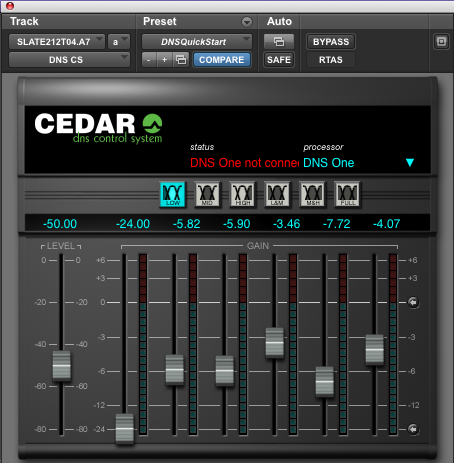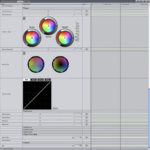
REVIEW: CEDAR DNS One Noise Reduction
Posted on Oct 5, 2010 by Alex Fice
CEDAR DNS One’s control system as reviewed by ALEX U’REN a freelance sound mixer
Recently I had the opportunity of trying out CEDAR Audio’s DNS One, the software plugin version of their now industry standard hardware units for background noise suppression, widely used for cleaning up noisy dialogue tracks in post-production for television and film. As many of you know, CEDAR released their first hardware DNS unit, the DNS1000, in 2000 to great acclaim.
According to CEDAR, its proprietary DNS filters are “optimized for removing hiss, broadband noise, ‘atmos’, shot noise, general background and reverberation from dialogue” – perfect for post. The DNS1000 was replaced by the improved DNS1500. Then the DNS2000 and DNS3000 were added to the hardware DNS line, both of which can be automated from within Pro Tools. For some years now users have been asking for a plugin version of the DNS units, and earlier this year DNS One was released.
What is it, exactly?
DNS One is an RTAS plugin for Pro Tools HD and LE v7.4 and higher, with the same Academy Award winning sound quality as the DNS hardware units. As of v4.1.0 it’s compatible with Mac OSX (Intel) 10.5 and higher, Mac OSX (PPC) 10.4 and higher and Windows XP and higher. Version 4.1.0 also includes AudioSuite support. Software authorization is via the provided USB HASP key.
Getting up to speed
Installation is very straightforward from the included CD-R. Installers are also downloadable from CEDAR’s website. Make sure the HASP key is plugged in before you launch Pro Tools. When you call up an instance of the plugin in Pro Tools what you are actually accessing is the DNS Control System (DNS CS), which is the RTAS interface to all software controllable DNS products, whether they be software or hardware. To date they are DNS One and the DNS2000 and DNS3000 hardware units. When you bring up a new instance of DNS CS, you must tell it you’d like to control an instance of DNS One by selecting it under the processor drop-down menu. You only need to do this once per new instance.
With the DNS Control System, sessions using DNS One can be moved with Pro Tools systems with DNS2000 and DNS3000 units, and vice-versa. It is fully integrated with Pro Tools automation and the Pro Tools D-Control and D-Command hardware control surfaces as well.
How do you work it?
One of the things I really like about the DNS One is its dead simple interface – seven faders and six frequency range selector buttons. For convenience there are also two reset arrow buttons for the GAIN faders (which we’ll discuss later). That’s it. I find this interface much simpler and easier to get quick results from than the other noise reduction plugins that I commonly use. The LEVEL fader acts as a threshold and the six GAIN faders reduce noise in different frequency bands, depending on which range selector button you click on. There’s Low (20Hz – 400Hz), Mid (200Hz – 6kHz), High (4kHz – 18kHz), Low+Mid (20Hz – 6kHz), Mid+High (200Hz – 18kHz) and Full (20Hz – 18kHz).
Because DNS One is optimized for this particular task, dialogue noise suppression, there is no need to take a ‘noise profile’ of just the type of noise you are trying to remove, as is the case with most noise reduction plugins.
Here’s a quick once over on use: Start with the LEVEL fader and six GAIN faders all the way down and select the Full range button. Here’s where you can use the lower reset arrow button to set all GAIN faders to -24 (maximum NR). Play your audio. Slowly raise the LEVEL fader until the noise you are trying to reduce disappears. Now press the upper reset arrow button to set all GAIN faders to zero (no NR). From here there is no NR applied, but the LEVEL fader is at a good starting threshold for the noise in the audio you’ve played it. Now for the art of using DNS One – use your ear to identify what part of the frequency spectrum the noise is in, and pull down an appropriate GAIN fader. You will usually need to pull down more than one fader to varying degrees. If you find that the noise is in a particular part of the spectrum you can then refine the frequency range for better results. Perhaps it’s just the two low end faders you’re grabbing for in Full frequency range mode. Select the Low range and start the above process again for more surgical results.
Performance
DNS One purportedly has zero latency, and I found that to be true when re-recording through the plugin onto another track. The re-recording was done with no noise reduction applied, so that the new track would contain the same audio. The two tracks completely cancelled when one was phase flopped. Not so with my other NR plugins with latency. How this voodoo is accomplished I don’t know, but I’m not complaining. This is good news for Pro Tools LE users, whose systems don’t have automatic delay compensation.
At one point I was running nine instances (on a Dual 2.8 GHz Quad-Core Intel Xeon Mac), which I thought would be a reasonable scenario for me. I checked the RTAS gauge and it was only at 8%. I find it to be surprisingly low on CPU consumption for what it does.
Put to the test
I tried DNS One out on production audio from the upcoming film ‘Dimensions‘, coincidentally shot in Cambridge, home of CEDAR Audio Ltd. The main audio issue with shooting the outdoor scenes for this period piece (set around the 1930s) was the sound of modern traffic on the two lane road about 50 meters away! Although traffic was stopped for each take (most of the time) the distant sound of modern vehicles could always be heard. I’ll be handling the post-production audio for this so I was keen to see what DNS One could do to help us out with this.
When applied to these tracks, in some cases I was able to all but completely remove the unwanted distant traffic noise. In others, the traffic noise was reduced to sounding like a light, distant breeze – perfectly acceptable, and it mixed in with the added BGs (background sfx tracks) just fine.
As a side note, I found myself sometimes working the GAIN faders from the bottom up instead of the top down. That is, once the noise threshold was set by the LEVEL fader I started with the GAIN faders at full NR and then started pulling them up to reveal the dialogue I was saving, stopping when I started to reveal background noise. Just another possible way to work. Your mileage may vary.
What impressed me the most was DNS One’s uncanny ability to target the background noise without affecting the dialogue. True, if you pull down a frequency GAIN fader in the dialogue range too far you do start pulling out dialogue frequencies. It’s always a balance, but for this sort of task I found that I could remove a lot more of what I didn’t want and leave a lot more of what I did want than with other NR plugins, and… no matter how hard I pushed it I never got those watery or chirpy artifacts like you can with the others.
A couple of other thing I noticed – it reduced the ‘heaviness’ of atmospheres from boom recordings in a way that just using a high pass filter doesn’t do. All I can say is that that it left ‘air’ in the track. Also, it reduced and softened some of the close up rustling sounds from in radio mic tracks.
The benefits of software
The DNS One has some nice advantages over the hardware units. Carry your HASP key and the installer on a thumb drive and you can use DNS One on any qualified Pro Tools system you travel to. Because the number of DNS One instances is only limited by your computer’s CPU, you can most likely have one on every dialogue track, each with a separate setting, and not have to worry about overlapping tracks. Also, you can have multiple instances on the same track. Say, three instances on a track, one set to the Low, one set to the Mid and one set to the High frequency range. You now have 18 narrower frequency bands to target noise, rather than six wider ones. This is especially useful when the same bit of audio has noise in both the high and low parts of the spectrum. Of course, at the present DNS One is specifically for Pro Tools, so you’d have to opt for a hardware DNS unit if you’re on another workstation.
Final Thoughts
For the specific task of removing unwanted broadband noise from dialogue recordings, DNS One does a superb job of attacking background noise while leaving the dialogue alone, with none of the artifacts sometimes exhibited by other NR software. Now I’m still going to take the time to edit out as much background noise as possible by hand before using it. But under dialogue, when there are no usable alternate takes and no time or money for ADR, it’s invaluable.
It’s worth mentioning that it is more expensive than other noise reduction software on the market, but I believe this is a positive case of ‘you get what you pay for’. Between its zero latency, low CPU usage, ease of use and ability save otherwise unusable dialogue tracks I believe DNS One is one plugin that’s worth saving for.
Alex U’Ren, Freelance Sound Mixer








